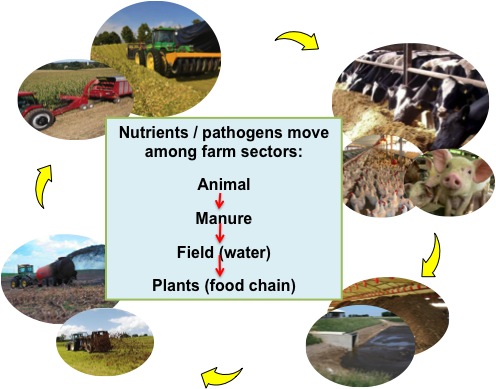Nitrogen, Phosphorus, and Integrated Management
Nitrogen and phosphorus are essential nutrients for growing plants and animals. Insufficient nutrients diminish yields; excessive applications translate to wasted resources and environmental pollution. The work of Dr. Dou’s group features an integrated system nutrient management approach, coupling nutrient optimization in animal feeding with manure management and targeted nutrient application to crops for enhanced production efficiency and reduced environmental footprint.
- Please see relevant projects and publications in 'Research Projects' and 'Publications' tab below.
Integrated whole farm management based on nutrients (pathogen) flow pathway

Pathogens, Antimicrobial Resistance (AMR), and Livestock Farming
Livestock animals are important reservoirs of zoonotic pathogens as well as antimicrobial resistant determinants (antibiotic residues, AMR microbes, and AMR genes). What happens to these “microbial pollutants” in the post-shed environment? How long do they survive under different management conditions? What is their distribution pattern in the intrinsically linked farming sectors and the dissemination pathways to the broader terrestrial and aquatic ecosystems? What intervention may help mitigate relevant risks associated with animal farming concerning food safety and public health? The research of Dr. Dou’s group addresses some of these critical issues.
- Please see relevant projects and publications in 'Research Projects' and 'Publications' tab below.
Food Waste, Food Security, and Sustainability
Sustainable food security is an issue that intersects many of the contemporary challenges the world is struggling to deal with today, e.g. water scarcity, water pollution, resource limitation, land degradation, habitat and biodiversity loss, climate change, and hunger and poverty. Dr. Dou collaborates with national and international experts to examine sustainable food security issues from multiple dimensions, such as food waste reduction and reuse, engaging, and empowering smallholder farmers, etc.
- Please see relevant projects and publications in 'Research Projects' and 'Publications' tab below.
Developing Novel Feeds from Food Waste and Crop Residue Biomass from Cows
Livestock farming is at a crossroads, its sustainable future challenged by competing interests for limited resources and urgent need to mitigate environmental and climate footprints, amid a rapidly growing global demand for animal protein. One viable solution overlooked, is to leverage the innate ability of animals as nature’s most effective recyclers, able to utilize a wide variety of plant biomass materials as feed resources in producing meats, milk, and eggs. This project will deploy an innovative sequential fermentation approach to create novel feeds for dairy cows using food waste of fruit and vegetable discards and post-harvest crop residues such as wheat straw and spent mushroom substrates, abundantly available but currently wasted or landfilled.
- Please see relevant projects and publications in 'Research Projects' and 'Publications' tab below.